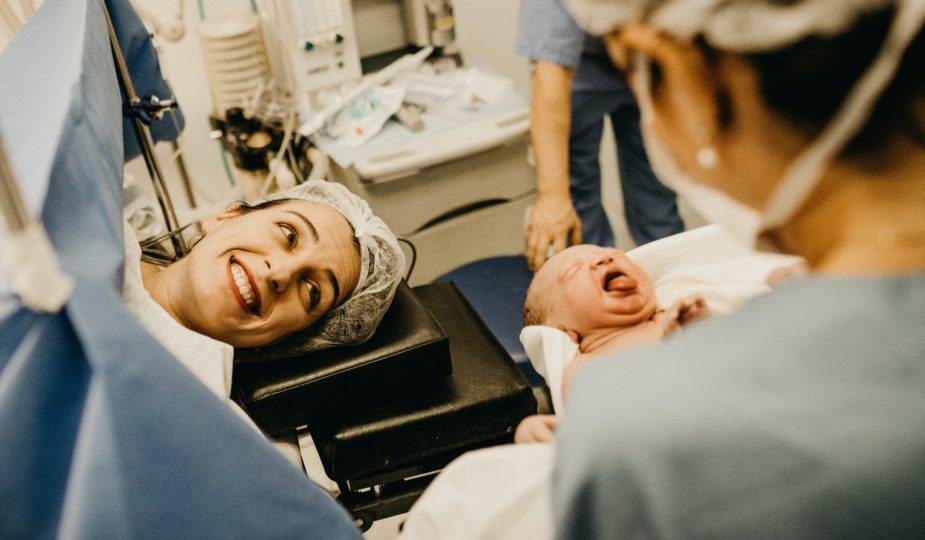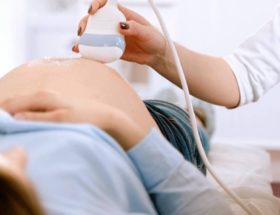The uterus is a hollow, pear-shaped organ that is located in a woman’s lower abdomen, between the bladder and the rectum. Is one of the most important organs in fertility because it carries and nurture your baby for 9 months. Before you get pregnant, the average uterus measures approximately 6 to 8 centimeters. During pregnancy, it grows all the way to reach the size of a watermelon (about 30 to 35 centimeters depending on the size of the baby). When the pregnancy reaches full term, the uterus will stretch from the pubic area to the base of the rib cage to fit your growing baby. Very interesting right? I agree. But like everything in this life, what grows has to return to its usual state later, and of course the uterus is no exception. Therefore, in this article I am going to give you 10 Ways to Naturally Shrink Uterus after Pregnancy. Ready? Let’s begin.
How to Naturally Shrink Uterus after Pregnancy.
Why is it so crucial for the uterus to shrink after giving birth?
The process of shrinking the uterus after giving birth goes beyond an aesthetic issue, I’ll explain below:
- Uterus contractions serve to pressurize the blood vessels in the area where the placenta is connected after the placenta is released after birth. As a result, severe bleeding is avoided.
- Blood vessels will bleed freely if the uterus does not contract or shrink after birth or a c-section, resulting in life-threatening postpartum hemorrhage.
- Excessive uncontrollable bleeding, pain, and backache are all symptoms that your uterus is not shrinking following a c-section or birth. If this is the case, you should discuss your symptoms with your doctor.
What normally happens after childbirth?
Soon after you give birth and remove the placenta, your uterus starts to shrink back to its pre-pregnancy size. Involution is the name for this kind of change. A few days after giving birth, you will be able to feel the uterus near your belly button. In a week or two, your uterus will be half the size it was right after you gave birth. Then, your uterus will move back into your pelvis and slowly return to its pre-pregnancy state. This will happen over time.
- After giving birth, your vaginal discharge is red and heavy. This is because the mucous membrane lining of your uterus is shedding after birth because it starts to shrink after birth. And after a few weeks, the vaginal discharge starts to go away on its own.
- Postpartum moms also have contractions or afterpain after giving birth, which is actually good because it stops too much bleeding by putting pressure on the blood vessels in the uterus.
- As a result, your uterus begins to contract immediately after you give birth, and it plays a crucial role in managing postpartum bleeding.
So, here you have 10 Ways to Help Your Uterus Shrink After a Pregnancy.
The uterus shrinks as a result of the physiological process of pregnancy, and it will take 6-8 weeks to return to its pre-pregnancy size and shape. This is because your hormones and uterine muscle are mostly responsible for the uterus shrinking after birth. However, if you want to aid your body, there are several things you can do to naturally decrease your uterus after giving child.
1. Don’t Underestimate the Power of Breastfeeding.
For both moms and babies, breastfeeding has a lot of benefits. It is better for women to breastfeed their babies because the hormone oxytocin is released and helps to make the uterus smaller. How? Let me explain: Oxytocin is commonly known as the love hormone. This hormone is produced by the pituitary gland, it is one of the fundamental hormones during the process of giving birth to a baby. In addition, this hormone is responsible for the production and ejection of breast milk during the breastfeeding process, is also the hormone that helps in the bonding process between mom and baby by creating chemical pathways in the mother’s brain that reduce stress and creates affection and love towards her newborn, and also It is the hormone responsible for the muscular contraction of the uterus. But in order to experience the benefits of this hormone not partially but one hundred percent after giving birth, it is necessary that you breastfeed your baby.
Breastfeeding helps to shrink the uterus because as the baby sucks on the breast, oxytocin the hormone I mentioned previously is released, which makes the milk flow and also the uterus to shrink. You then start to feel pain or cramps in your abdomen, which means that your uterus is getting smaller. A few days into postpartum, the cramps start to ease off.
For women who can’t breastfeed or choose to feed their babies formula, their uterus will take a little longer to return to its normal size and shape after giving birth. The hormone oxytocin is also released when you pump breast milk but in smaller quantities, which causes the uterus to shrink as well but more slowly. Therefore, those women might experience more cramping and heavy bleeding during the first few months in the postpartum period.
2. Consider using a Postpartum Girdle as soon as you can.
Another natural method that moms have used for millennia to shrink the uterus after birth is belly binding wrap. While there is no scientific evidence that wearing a belly wrap or postpartum girdle helps the uterus shrink, a few studies demonstrate that wearing one alleviates bodily pains and supports the body after birth.
If you’re going to use belly wrap to bind, you’ll want to learn how to apply it properly. However, postpartum girdles are designed expressly for this purpose and have hooks or a zipper for convenience of usage. Abdominal binding with a postpartum wrap or girdle assists in tightening the abdominal muscles and connective tissues.
The greatest effect of wearing a belly band or postpartum girdle occurs during the first six to eight weeks postpartum, when the hormone Relaxin is at its highest concentration in your body. If you have passed the 6–8-week window, it is not too late to wear a postpartum belly wrap. If you are breastfeeding, you can continue to wear it until 5 months postpartum because the Relaxin hormone is still present at a low level.
Additionally, the postpartum girdle or belly wrap is beneficial for moms who suffer diastasis recti, or abdominal muscle separation.
3. Uterine Massages.
Uterus massage, or fundal massage, is another technique for assisting the uterus in shrinking following birth. Additionally, uterine massage following placenta delivery has been shown to increase uterine contraction.
Uterus massage is performed by placing a hand on the lower abdomen and stroking and squeezing the uterus. The constant massage and squeezing helps remove blood clots from the uterus, which helps prevent postpartum hemorrhage.
Although fundal uterus massage is painful, you can endure it with the help of the breathing exercises you can learn in childbirth class, as well as how to perform the uterine massages yourself.
4. Warm compresses can be very helpful.
Use a warm compress on your abdomen to get relief right away from pain caused by your uterus contracting, which can be painful. If you want, you can put a heating pad or a warm washcloth on your abdomen. As a result, you don’t want to use a heating pad on your abdomen very often, because it can make your uterus contract more quickly.
5. Practice Sitz-bath after giving birth.
You can also take a warm bath or do a sitz-bath after giving birth. It is a gentle way to make it easier for your uterus to contract. Also, a warm bath is very soothing when your whole body hurts in the first week after giving birth.
6. Herb to shrink the uterus
People in Europe and Asia often use dill (Anethum graveolens) as a spice in their food. It is also used to make food, but it is also used to treat digestive problems, relieve menstrual cramps, among other things.
Traditionally, Indians have used Dill Water (also called Suva Water) to help them recover after giving birth. This water has been used for a long time. A lot of people say that it helps the womb/uterus shrink back to its original size and shape. It also helps the body get rid of any toxins that were left in the body after giving birth.
Drain out the seeds from one tablespoon of dill and add them to one cup of water. Boil for about 7 minutes. You can drink it hot or cold. After giving birth, you can drink dill water at any time. Just keep in mind that the taste of this water might not be very pleasant for some people. And also, don’t forget to always do your own research or consult with your doctor before drinking anything.
7. Stay well-hydrated.
Staying hydrated is important in general, but it is even more important after giving birth. When you drink enough water, not only does it help you make breast milk, but it also flushes toxins out of your body and moves things along.
There is no need to drink more water than you need. When you breastfeed, you should drink one glass of water each time and then drink when you’re thirsty. This will keep you hydrated after you have a child.
8. Nurture your body by Consuming Nutritious Foods.
Consuming healthful foods is critical postpartum. Consume three nutritious meals plus snacks in between to maintain your milk production and to provide your body with the resources it needs to recuperate after birth.
Related post: Pregnancy diet. Proper nutrition during and after pregnancy.
When caring for a baby, it’s never easy to find time to prepare a nutritious dinner. Therefore, plan your meals or adapt to a nursing meal plan that includes basic recipes and ingredient lists so that you don’t have to spend too much time deciding what to cook each day.
9. Abstain from Exercise.
Be kind with yourself throughout the first six to eight weeks following birth. After labor and delivery, your body requires time to heal. You should avoid exercising until your doctor gives the green light.
While bodily motions and walking are acceptable, you do not want to overexert your body in the first few of weeks following birth.
10. Keep Taking Your Prenatal Vitamins.
During the process the woman’s body tends to lose blood, after childbirth follows the process of breastfeeding a baby. All of these processes, although a natural part of life, put a lot of stress on a woman’s body that she needs to heal.
Following delivery, vaginal bleeding is also normal for a few weeks, sometimes longer. Therefore, the consumption of prenatal vitamins, in addition to helping you with breastfeeding, will also help your body to heal faster and everything to return to its normal state faster, and that includes the uterus as well.
Along with eating nutritious meals, make sure you keep taking your vitamins on a regular basis to compensate for nutrients deficient in your diet.
Share this article.

Common questions women usually have after childbirth about uterus involution.
How long does the uterus take to shrink?
The uterus begins shrinking immediately after delivery of the placenta, but it takes approximately 6-8 weeks to recover to its pre-pregnancy size. Soon after birth, you will be able to feel your solid uterus at the level of your belly button. The most substantial uterine shrinkage occurs within the first week following birth, when the uterus shrinks about half its size. It occurs when you experience abdominal pain or contractions, which significantly reduces postpartum bleeding.
It weights roughly 50gms after six weeks. Progesterone and estrogen deprivation also aids in uterine shrinkage by boosting uterine activity.
Whether you delivered vaginally or via c-section, it takes approximately 6-8 weeks for the uterus to return to its pre-pregnancy size. However, if you choose not to breastfeed or are unable to breastfeed, it may take approximately 8-10 weeks for your uterus to contract after birth.
Can you feel your uterus contracting following birth, or feel any pain?
Yes, the stomach pain and cramps you experience following birth indicate that your uterus is contracting. You will experience abdominal pain and cramping in the first few days following delivery, but these symptoms will subside within a few days.
You will also have abdominal pain and cramps as your uterus begins to shrink back to its pre-pregnancy size and shape. These cramps are comparable to menstruation cramps. During the first few days of breastfeeding, you will experience a sharp ache. The intensity of pain diminishes as the postpartum period progresses.
Is pumping beneficial for uterine shrinkage?
As with nursing, stimulating your nipple with a pump induces the release of oxytocin and contraction of the uterus. During the first several weeks of pumping, you may have abdominal pain or cramps, which indicates that your uterus is contracting or shrinking.
How quickly does the uterus shrink if you do not breastfeed or pump?
Generally speaking, the uterus takes 6-8 weeks to shrink after birth if you breastfeed. For moms who only pumps might take a bit longer, probably about 8-10 weeks for the uterus to shrink back down after giving birth. For those moms who decides not to breastfeed or pump it might take even longer, perhaps 10-12 weeks depending on the hormones.
Related posts you might like to check about pregnancy.
How to Relieve Stress During Pregnancy.
How to Get Rid of Round Ligament Pain During Pregnancy.
Pregnancy diet. Proper nutrition during pregnancy.
Planning To Quit Smoking for A Healthy Pregnancy? 9 Tips to Ease the Journey.
Is Covid Vaccine Safe During Pregnancy?
Final thoughts about How to Naturally Shrink Uterus after Pregnancy.
You should know when your uterus will shrink after giving birth and what you can do to speed up the process.
It’s very important to wear a postpartum girdle or belly wrap for the first 6 to 8 weeks after giving birth. If your uterus starts to shrink, this will help your body while you are breastfeeding and will help your body while you are taking care of your newborn.
I hope this article was helpful to you. If you have any more questions about shrinking the uterus naturally after having a baby, let me know in the comment box below. Thanks for reading, I’ll see in my next article.
Zadi, xo
Disclaimer: The medical information on this post is for educational and entertainment use only. Under no circumstances, this information is to replace your doctor’s advice or to treat any disease. For proper care, always visit your doctor.










Wow very helpful article, I wish I new all of this valuable information before!! Passing this information to other women I know.
Very helpful article. I am having a baby in a month and I am planning to use all your tips.
I am happy to help Brielle. Thanks for leaving a comment.
Thank you so much dear, I really appreciate your interest in sharing our blog.
[…] How to Naturally Shrink Uterus after Pregnancy. […]
[…] How to Naturally Shrink Uterus after Pregnancy. […]
[…] How to Naturally Shrink Uterus after Pregnancy. […]
[…] How to Naturally Shrink Uterus after Pregnancy. […]